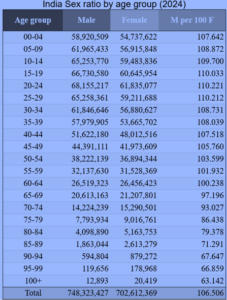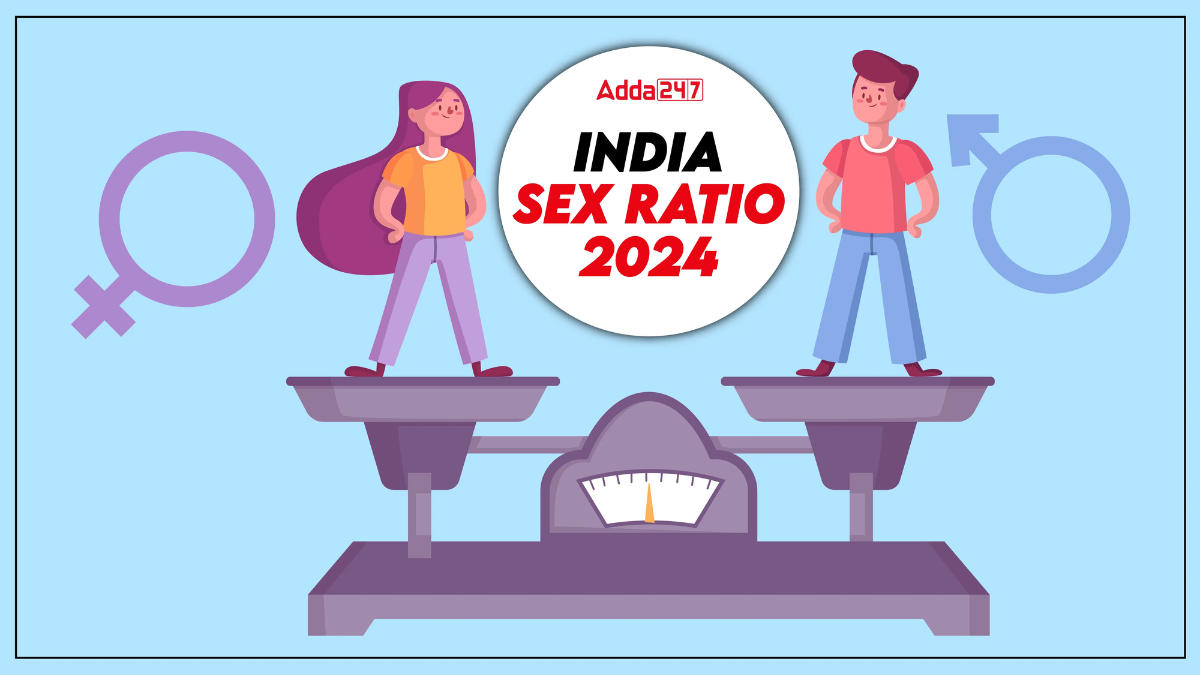Table of Contents
The sex ratio in India shows the number of females for every 1000 males. While more boys are born than girls, women tend to live longer, so the gap narrows with age. Population size changes due to birth rates, death rates, immigration, and emigration. Births increase populations, deaths decrease them, and immigration adds people while emigration removes them. Tracking this data helps understand population trends in India.
Indian Sex Ratio 2024
The India Sex Ratio 2024 is an important measure of gender equality. By collecting data on males and females, it helps us understand important issues like fertility, mortality, marriage, employment, and migration. This information offers valuable insights into the social and economic trends in Indian society.
| Present Sex Ratio in India |
| As of 2024, India’s population is about 1.44 billion, with 743.39 million males and 698.29 million females. This gives a sex ratio of 106.5 males for every 100 females. Males make up 51.56% of the population, while females are 48.44%, resulting in about 45.08 million more males than females. India ranks 214th out of 236 countries in its female-to-male ratio, indicating a significant imbalance. |

Sex ratio and Child sex ratio in India
Projected India Sex Ratio by 2036
A government report predicts that India’s population will reach 1.52 billion by 2036, with an improved sex ratio. The ratio is expected to rise from 943 females per 1000 males in 2011 to 952 by 2036. This forecast comes from the “Women and Men in India 2023” report by the Ministry of Statistics and Programme Implementation (MoSPI). The report also expects a slight increase in the female population, from 48.5% in 2011 to 48.8% in 2036.
Fertility Trends and the Role of Education
The fertility rate for women aged 20-24 and 25-29 has decreased, while there’s a slight rise for those aged 35-39, indicating that more women are choosing to have children later. However, the adolescent fertility rate is much higher among illiterate women compared to those with education. This highlights the importance of education in improving women’s health, family planning, and overall social outcomes.
Demographic Shifts and Trends
The MoSPI report highlights several important trends: the proportion of people under 15 is declining due to lower fertility rates, while the number of elderly individuals (60 and older) is increasing. These changes suggest a more mature population and progress towards gender balance. The report also notes differences in gender equality between urban and rural areas, as well as across different regions.
What is the India Sex Ratio 2024?
In 2024, India has 106.5 men for every 100 women, with a male population of 748.32 million and a female population of 702.61 million. There are 45.71 million more men than women in the country. India ranks 218th globally for the male-to-female ratio and 40th among Asian countries.
At birth, India has 107.1 boys for every 100 girls, making it one of the most imbalanced sex ratios worldwide. The gender gap is widest among people aged 20-24 and in the 0-14 age group, with more boys than girls. However, the male-to-female ratio decreases with age, and by 2100, it is expected to drop to 102.4. Overall, India has a male surplus, particularly among younger age groups, but the gap narrows in older populations.
According to the 2011 Census, India’s gender ratio was 943 females per 1000 males, with rural areas having a ratio of 949 females per 1000 males, and urban areas 929 females per 1000 males. The sex ratio improved from 933 in 2001 to 943 in 2011, with rural areas showing a gain of 3 and urban areas 29. In 1901, India had its highest recorded sex ratio of 972 females per 1000 males.
| Types of Sex Ratio |
There are 4 types of sex ratios divided according to the stages of development.
|
India Sex Ratio 2024
The 2024 sex ratio in India shows a strong preference for males, leading to serious issues. Gender inequality, a desire for male children, and harmful practices like female infanticide and feticide are particularly concerning in rural areas, where parents often choose their child’s gender. The rapid decline in sex ratios poses a significant risk to women, as the bias toward male children results in an imbalance and higher mortality rates among female fetuses.
- Formula to calculate Sex Ratio in India 2024
India Sex Ratio = (Number of Females / Number of Males) x 1000
As per the stats in the 2011 Census among the total population of 1210.1 million, the male population – 623.7 and the female population – 586.4 million. Indian sex ratio stood at 943 (stating that for every 1000 males, there are 943 females). There are 949 females to 1000 men in rural areas, while in an urban area, there are 929 females to 1000 males.
| Indian Sex Ratio 2024 (NFHS-5 Survey) | |
| Total Overall | 1020 females as per 1000 males |
| Rural Areas | 1037 females as per 1000 males |
| Urban Areas | 985 females as per 1000 males |
NFHS-5 Survey on Indian Sex Ratio
The National Family Health Survey (NFHS-5) for 2020-21 found that India’s sex ratio in 2023 was 1,020 females for every 1,000 males. In rural areas, the ratio is 1,037, while in urban areas, it is 985 females per 1,000 males.
The sex ratio at birth remains low, although it improved by 15 points in 2022-23 to 933. For children born in the last five years, the ratio is 929 females per 1,000 males. This is an improvement from a record low of 896 in 2015-17. Kerala has the highest sex ratio in India, at 1,084 females for every 1,000 males. Overall, India’s gender ratio is lower than in developed countries.
| Sex Ratio (Females per 1000 Males) | 2011 Census | 2023 (NFHS-5 Survey) |
| Rural | 949 | 1037 |
| Urban | 929 | 985 |
| India | 943 | 1020 |
| Indian Sex ratio Male-Female Ratio in India 2024 |
|
Government Initiatives for Sex Ratio
India has tackled sex prediction and abortion-related issues through the Pre-conception and Pre-natal Diagnostic Techniques Act. Important initiatives like the Sabla Scheme, Beti Bachao Beti Padhao Scheme (2015), and Kasturba Gandhi Balika Vidyalaya aim to reduce gender inequality and promote girls’ health and education. These efforts are expected to significantly improve the sex ratio by focusing on the well-being and empowerment of girls. Notable steps include:
- Ultrasound equipment notified in 2020, as drug under Drugs and Cosmetic Act, 1945. The licenses from Drug Controller of India made mandatory for selling/importing/ R&D of Ultrasound Machines.
- Regular monitoring through National Inspection and Monitoring Committee (NIMC) for implementation of Pre Natal Determination Act.
- Constitution of State Inspection and Monitoring Committees (SIMC).
Factors for Sex Ratio in India
The Sex Ratio in India depends on numerous factors that cause differences, you can read detailed information.
- Rates of death and life duration i.e., women typically live males. Studies show that women should expect to live longer than men do.
- Biased Male Births: The reason behind the higher number of male births than female births is defined by biological considerations and the preference for men over girls.
- Female infanticide and the taboo of sex determination and termination of girl pregnancy have resulted in low and depleting sex ratios.
- Migration patterns and male-dominant labor is required.
- Families opting for nuclear trends with only One Child if the firstborn is a Male.
- People get tempted by the future Male Income and that the male would carry forward the lineage and help the parents in the old age. Whereas females are considered burdens economically because of their Dowries, they are taken as Liabilities. Hence the preference of males over females.
State Wise Sex Ratio in India
A comprehensive summary of sex ratios and their variations across India’s states and union territories is presented in the table below. The data includes sex ratios at birth and child sex ratios, sourced from surveys conducted in 2001, 2011, and NHFS-5.
| No. | State/Union Territory | NHFS-5 | 2011 Census | 2001 Census | Change (2001 to 2011) | Rank (Sex ratio at birth) |
|---|---|---|---|---|---|---|
| 1 | Lakshadweep (UT) | 1051 | 947 | 911 | 948 | 959 |
| 2 | Tripura (S) | 1028 | 960 | 957 | 948 | 966 |
| 3 | Meghalaya (S) | 989 | 989 | 970 | 972 | 973 |
| 4 | Uttarakhand (S) | 984 | 963 | 890 | 962 | 908 |
| 5 | Arunachal Pradesh (S) | 979 | 938 | 972 | 893 | 964 |
| 6 | Karnataka (S) | 978 | 973 | 948 | 965 | 946 |
| 7 | Jammu and Kashmir (UT) | 976 | 889 | 862 | 892 | 941 |
| 8 | West Bengal (S) | 973 | 950 | 956 | 934 | 960 |
| 9 | Mizoram (S) | 969 | 976 | 970 | 935 | 964 |
| 10 | Sikkim (S) | 969 | 890 | 957 | 875 | 963 |
| 11 | Manipur (S) | 967 | 992 | 930 | 978 | 957 |
| 12 | Assam (S) | 964 | 958 | 962 | 935 | 965 |
| 13 | Chhattisgarh (S) | 960 | 991 | 969 | 989 | 975 |
| 14 | Puducherry (UT) | 959 | 1037 | 967 | 1001 | 967 |
| 15 | Madhya Pradesh (S) | 956 | 931 | 918 | 919 | 932 |
| 16 | Gujarat (S) | 955 | 919 | 890 | 920 | 883 |
| 17 | Kerala (S) | 951 | 1084 | 964 | 1058 | 960 |
| 18 | Nagaland (S) | 945 | 931 | 943 | 900 | 964 |
| 19 | Uttar Pradesh (S) | 941 | 912 | 902 | 898 | 916 |
| 20 | Andhra Pradesh (S) | 934 | 993 | 939 | 978 | 961 |
| 21 | Delhi (UT) | 923 | 868 | 871 | 821 | 868 |
| 22 | Andaman and Nicobar Islands (UT) | 914 | 876 | 968 | 846 | 957 |
| 23 | Maharashtra (S) | 913 | 929 | 894 | 922 | 913 |
| 24 | Bihar (S) | 908 | 918 | 935 | 919 | 942 |
| 25 | Punjab (S) | 904 | 895 | 846 | 876 | 798 |
| 26 | Jharkhand (S) | 899 | 948 | 948 | 941 | 965 |
| 27 | Telangana (S) | 894 | 988 | – | – | – |
| 28 | Odisha (S) | 894 | 979 | 941 | 972 | 953 |
| 29 | Haryana (S) | 893 | 879 | 834 | 861 | 819 |
| 30 | Rajasthan (S) | 891 | 928 | 888 | 921 | 909 |
| 31 | Tamil Nadu (S) | 878 | 996 | 943 | 987 | 942 |
| 32 | Himachal Pradesh (S) | 875 | 972 | 909 | 968 | 896 |
| 33 | Goa (S) | 838 | 973 | 942 | 961 | 938 |
| 34 | Chandigarh (UT) | 838 | 818 | 880 | 777 | 845 |
| 35 | Dadra and Nagar Haveli (UT) | 817 | 774 | 926 | 812 | 979 |
| 36 | Daman and Diu (UT) | 817 | 618 | 904 | 710 | 926 |
Highest Sex Ratio, State Wise List 2024
- States Wise Highest Sex Ratio in India 2024 (according to Census 2011) are defined under the data available from 2001 to 2011 where the Indian Sex Ratio has been considered to be the highest sex ratio in the Indian states
| States List Highest Sex Ratio in India(according to Census 2011) | Sex Ratio |
|---|---|
| Kerala | 1084 |
| Tamil Nadu | 996 |
| Andhra Pradesh | 992 |
- States Wise Lowest Sex Ratio in India 2024- The data available is from 2001 to 2011 where the Indian Sex Ratio for lowest Set Ratio in the states.
| States List Lowest Sex Ratio in India | Sex Ratio |
|---|---|
| Haryana | 879 |
| Jammu and Kashmir | 883 |
| Sikkim | 889 |
- Union Territories Wise Highest Sex Ratio in India 2024- The following data available is from 2001 to 2011 where the Indian Sex Ratio is seen for Union Territories of India with Highest Sex Ratio.
| Union Territories with Highest Sex Ratio in India | Sex Ratio |
|---|---|
| Puducherry | 1037 |
| Lakshadweep | 946 |
| Andaman and Nicobar Islands | 878 |
- Union Territories with Lowest Sex Ratio in India 2024- from the Year 2001 to 2011 The Indian Sex Ratio for both sex males and females is seen as the lowest sex ratio in the union territories of India.
| Union Territories with Lowest Sex Ratio in India | Sex Ratio |
|---|---|
| Daman and Diu | 618 |
| Dadra and Nagar Haveli | 775 |
| Chandigarh | 818 |
Indian Sex Ratio in Delhi
Delhi, India saw a significant increase in its sex ratio in 2022, going from 809 in 2001 to 929. With more females than males for every 1000, this shows a trend in the right direction toward establishing gender balance in the nation’s capital.
| Year | Sex Ratio (Females per 1000 Males) |
|---|---|
| 2001 | 821 |
| Latest Census | 868 |
Lowest Indian Sex Ratio States in India
The state with highest Sex Ratio in India is Kerala which has a sex ratio of 1058 females for every 1000 males. The primary reason is that Kerala is the most literate state in the country and there is no female foeticide, hence a balanced sex ratio.
| Total Population | 2011 Census | 2001 Census |
| 3.34 million | 3.18 million | |
| Males | 16,027,412 | 15,468,614 |
| Females | 17,378,649 | 16,372,760 |
| % Total Population of India | 2.76% | 3.10% |
According to the National Health Survey 2019-21, the following states in the country have the lowest sex ratio:
| S. No | States | Sex Ratio |
| 1 | Haryana | 926 |
| 2 | Punjab | 938 |
| 3 | Gujrat | 965 |
| 4 | Maharashtra | 966 |
| 5 | Madhya Pradesh | 970 |
| 6 | Sikkim | 990 |
| 7 | Arunachal Pradesh | 997 |
Indian Sex Ratio Facts and Stats
- The sex ratio in India has shown a depletion since 1951 in the Census data with the overall sex ratio falling from 972 in 1951 to 943 in 2011.
- The rural population of India depleted from 965 to 946 and the urban population increased from 860 to 929 in 2011.
- Sex Ratio at Birth (SRB) is used to measure globally i.e. the number of boys born per 100 girls whereas India uses a different method by recording female births per 1,000 male births irrespective of specifying age groups.
- Within the States, Kerala has the highest sex ratio i.e. 1084 while Haryana has the lowest i.e. 879.
- Within Union Territories, Puducherry has the highest i.e. 1037, and Daman and Diu mark the lowest at 618.
- States that have seen an increase in Sex Ratio are Andaman and Nicobar Islands (40.16 %), Delhi (13.02 %), Assam (10.34%), and West Bengal (9.82%).
- States that have seen declining Sex Ratio are Daman & Diu (45.03%), Dadra & Nagar Haveli (18.19%), Goa (13.71%), Lakshadweep (9.25 %), and Bihar (8.21%).
- The only two UTs with a Sex Ratio of more than 900 females per 1000 males are Puducherry and Lakshadweep.
- There were 108.18 males for every 100 in the total population of Indian women by the year 2020.
- Union Territories – the Andaman and Nicobar Islands, Delhi, Chandigarh, Dadra, Nagar Haveli, and Daman and Diu have been ranked in the bottom five.
- In India, there are 662,903,415 or 662.90 million females and 717,100,970 or 717.10 million males.
- According to the Report of the United Nations (World Population Prospects 2019), India’s total population comprises a sex ratio of 108.18 males per 100 females in 2020 having the highest male population with 54.20 million.
- Sex ratios in various age groups in 2011 were 918 for 0-6 years, 908 for 0-19 years, 944 for 15-45 years, and 1033 for 60+ years.
Women’s Indian Sex Ratio in India 2024
Find out the complete report about Women’s Sex Ratio in India 2024. In the below point, the sex ratio of the Indian population is described.
- In rural areas, this ratio is 985 females per 1000 males, which marks an improvement from the 2011 census.
- As per the National Family Health Survey (NFHS-5) 2020-21 sex ratio report, in 2024, the Indian gender ratio will be 1020 females per 1000 males.
- The 2011 census reported a National sex ratio of 943 females per 1000 males.
- Government initiatives aimed at combating gender-based sex selection and banning gender-specific sex tests have contributed to this positive change over the past decade and helped the status get better.
- The sex ratio at birth in India for the last five years is 929 females for every 1000 males, indicating a shift in societal attitudes and behaviors toward achieving a more balanced gender ratio.
| Location | 2011 Census | 2023 (NFHS-5 Survey) |
|---|---|---|
| Rural | 949 | 1037 |
| Urban | 929 | 985 |
| India | 943 | 1020 |
Tamil Nadu Sex Ratio 2024
As of the latest census, Tamil Nadu’s sex ratio is 996 females for every 1,000 males, which is notably higher than the national average of 940. This represents an improvement from the 2001 census, when the ratio was 987 females per 1,000 males.
| Last 4 years Sex ratio in Tamil Nadu | ||
| Year | In Crores | In Numbers |
| 2011 | 7.21 Crores | 72,147,030 |
| 2021 | 8.21 Crores | 82,070,000 |
| 2022 | 8.31 Crores | 83,070,000 |
| 2023 | 8.39 Crores | 83,930,000 |
Infant Sex Ratio in India or Child Ratio in India
The natural “sex ratio at birth” typically hovers around 105, meaning that, on average, there are 105 male infants for every 100 female infants. A significant departure from this ratio of 1.05 boys for every girl at birth indicates an uneven child-sex ratio. In India’s case, up until 1981, there existed a balanced child-sex ratio. However, according to the 2011 census, a major Indian city, Jhajjar, displayed an anomaly with almost 15,000 more male newborns than female newborns, resulting in a ratio of 128 boys for every 100 girls. The high-density Child Sex Ratio in India under the 0 to 6 years age group is described in the table mentioned below.
| Child Sex Ratio in India (0-6 years) | High Density |
| Mizoram | 971 |
| Meghalaya | 970 |
| Chhattisgarh | 964 |
The Lowest density Child Sex Ratio in India under the 0 to 6 years age group is described in the table mentioned below.
| Child Sex Ratio (0-6 years) | Lowest Desnity |
| Haryana | 830 |
| Punjab | 846 |
| J&K | 859 |
Child Sex Ratio Acc to Census 2011 (0-6 Year)
Description of top 8 states with high to low points of Child Sex ratio according to the census 2011 for the age group of 0-6 years. This data will be helpful in understanding the status better
| Child Sex Ratio Census 2011 ( 0-6 years) | |
| Punjab | 798 to 846, +57 points |
| Haryana | 819 to 830, +11 points |
| Himachal Pradesh | 896 to 906, +10 points |
| Chandigarh | 845 to 867, +22 points |
| Gujarat | 883 to 886, +3 points |
| Tamil Nadu | 942 to 946, +4 points |
| Mizoram | 964 to 971, +7 points |
| Andaman & Nicobar Islands | 957 to 966, +9 points |
Indian Population Growth Ratio Per Year
India’s population has consistently expanded, reaching 1,428,627,663 in 2024, reflecting a 0.81% growth from the previous year (2022) when it was 1,417,173,173. This ongoing trend shows a 0.68% increase in 2022 compared to 2021 (1,407,563,842), and in 2020, the population was 1,396,387,127, marking a 0.96% rise from 2019.
| Year | Population | Annual Growth Rate |
|---|---|---|
| 2019 | 1,396,387,127 | 0.96% |
| 2020 | 1,407,563,842 | 0.80% |
| 2021 | 1,417,173,173 | 0.68% |
| 2022 | 1,428,627,663 | 0.81% |
| 2023 | 1,428,627,663 (est.) | 0.81% (est.) |
Indian Sex Ratio 2022
Indian Sex Ratio 2022: The Ministry of Statistics and Programme Implementation in the Women and Men in India 2022 report stated under Indian Sex Ratio 2024.
- The expected Indian Sex Ratio 2024 is projected to improve from 943 in 2011 to 952 by 2036.
- Furthermore, the report suggests that India’s population growth is projected to fall to 0.58% by 2036 from 1.1% in 2021.
- However, the female population is projected to marginally improve from 48.5% in Census 2011 to 48.8% in 2036.
Indian Sex Ratio in context of Transgender
| Top 5 Transgender Populated States in India | |
| Total Population | 4,87,803 |
| Uttar Pradesh | 28.18% |
| Andhra Pradesh | 8.97% |
| Bihar | 8.37% |
| West Bengal | 6.22% |
| Tamil Nadu | 4.58% |
Gender Ratio in India
There are 717,100,970 or 717.10 million males and 662,903,415 or 662.90 million females in India. The percentage of the female population is 48.04 percent compared to 51.96 percent male population. India has the highest numbers of exceed males population of 54.20 million
Male and Female Ratio in India 2024
As of January 2023, India had a massive population of 1.42 billion people, making it the world’s second most populous country. In the year 2022 to 2023, India’s population grew by 9.7 million, which is a 0.7 percent increase. There’s almost an equal number of males and females, with 51.6 percent being male and 48.4 percent female. When it comes to where people live, 36.1 percent call cities their home, while the majority, 63.9 percent, live in rural areas, highlighting a significant difference between rural and urban populations.
Indian Sex ratio of India From 1901 to 2021
| Census Year | Sex Ratio (females/1000 males) |
| 1901 | 972 |
| 1911 | 964 |
| 1921 | 955 |
| 1931 | 950 |
| 1941 | 945 |
| 1951 | 946 |
| 1961 | 941 |
| 1971 | 930 |
| 1981 | 934 |
| 1991 | 927 |
| 2001 | 933 |
| 2011 | 943 |
| 2021 | 1,020 |
Indian Sex Ratio of States and UTs Data
| State/UT Rank | Name of state/ Union Territory | Indian Sex Ratio 2021 |
| 1. | Kerala | 1084 |
| 2. | Puducherry | 1038 |
| 3. | Tamil Nadu | 995 |
| 4. | Andhra Pradesh | 992 |
| 5. | Chhattisgarh | 991 |
| 6. | Manipur | 987 |
| 7. | Meghalaya | 986 |
| 8. | Odisha | 978 |
| 9. | Mizoram | 975 |
| 10. | Himachal Pradesh | 974 |
| 11. | Karnataka | 968 |
| 12. | Goa | 968 |
| 13. | Uttarakhand | 963 |
| 14. | Tripura | 961 |
| 15. | Assam | 954 |
| 16. | Jharkhand | 947 |
| 17. | West Bengal | 947 |
| 18. | Lakshadweep | 946 |
| 19. | Nagaland | 931 |
| 20. | Madhya Pradesh | 930 |
| 21. | Rajasthan | 926 |
| 22. | Maharashtra | 925 |
| 23. | Arunachal Pradesh | 920 |
| 24. | Gujarat | 918 |
| 25. | Bihar | 916 |
| 26. | Uttar Pradesh | 908 |
| 27. | Punjab | 893 |
| 28. | Sikkim | 889 |
| 29. | Jammu& Kashmir | 883 |
| 30. | Andaman & Nicobar islands | 878 |
| 31. | Haryana | 877 |
| 32. | NCT of Delhi | 866 |
| 33. | Chandigarh | 818 |
| 34. | Dadra and Nagar Haveli | 775 |
| 35. | Daman and Diu | 618 |
| Overall | India | 943 |
Reasons for Declining Indian Sex Ratio
The declining sex ratio in India is caused by several factors:
Son Preference: Cultural bias favors male children, leading to sex-selective practices.
Gender Disparity at Birth: More boys are born than girls.
Female Infanticide: Illegal but still practiced in some areas.
Sex Determination Testing: Tests for gender lead to abortions if the fetus is female.
Ineffective Laws: Difficulty enforcing laws against sex selection.
Small Family Norms: Some couples choose smaller families if they have a male child.
Dowry Practices: Economic pressures related to dowries can lead to neglect of female children.
Surplus of Males: An imbalance can create social issues as men struggle to find partners.



 TSPSC Group 1 Question Paper 2024, Downl...
TSPSC Group 1 Question Paper 2024, Downl...
 TSPSC Group 1 Answer key 2024 Out, Downl...
TSPSC Group 1 Answer key 2024 Out, Downl...
 UPSC Prelims 2024 Question Paper, Downlo...
UPSC Prelims 2024 Question Paper, Downlo...
